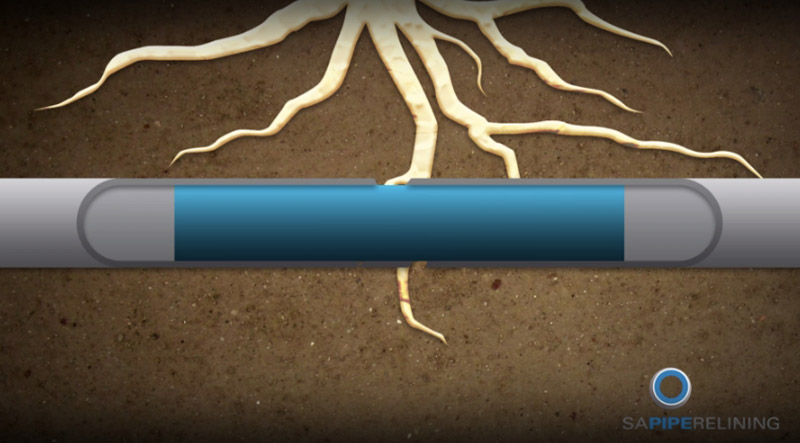
Pipe relining is becoming a commonly used method when it comes to fixing broken or blocked drains because it is cost-effective and efficient when compared to other known traditional methods of fixing pipes and drain repairs.
This system is also referred to as a trenchless pipe repair technology because it does not require digging a trench to gain access to the pipes for replacement. Instead, the pipes are fixed right where they are with little or no upturning of the soil. This is what SA Pipe Relining leverages on.
Procedures Used In Pipe Relining
The first step carried out before a pipe relining is done is examining the damaged pipe with the use of a CCTV camera. This inspection is to determine the level of damage in the pipe and consequently, decide if the pipes should be relined or completely overhauled.
After the decision to reline the pipe, the pipe is cleaned using a hydro-jetter—which supplies water in very high pressure—to remove the grease and oils in it. This is necessary because resin would not bond with all of that residue in the pipe. If this is not done properly, it could cause uneven linings in the newly formed pipe.
When the pipe is certainly clean enough, the lining materials are assembled. The liner is placed into a calibration tube which pushes out the liner when it is time for curation. The calibration tube is usually made of polyester or fiberglass. After that, the two-part epoxy resin is properly mixed.
The liner is compressed in an inversion trailer to ensure that the epoxy reaches all the fiber in it. This is called the wetting-out. After this is done, the liner may be kept in a bowl of ice to prevent it from curing before it is placed.
Next, the liner is loaded into the inversion tank, and the lining process starts. The pipe is filled with the epoxy through an access point upstream (it could also be filled from downstream, but it may pose some risks).
The resin is cured to make it harden up. Perhaps, this is why this system of relining is referred to as cured-in-place because the resin is left to air-dry or the process is hastened with the use of hot water or steam after placement and not cured before being fixed. Ultraviolet light is finally used in the tube to complete the curing process.
When the resin is completely dried and hardened to form the new pipe, a robotic cutter is employed to open up all the junctions that were closed up when the epoxy was forced in. In the absence of a robotic cutter, any other level cutter can be used to open up the spaces.
Finally, the pipe is checked to ensure that the work was properly done without wrinkling or open spaces in the resin.
How Long Does Pipe Relining Last?
The trenchless system of fixing pipes is no doubt, durable but the warranty offered by pipe relining services may differ. Generally, all liners come with a 10-year installation warranty which is fair enough. Nonetheless, SA Pipe Relining offers you a 50-year warranty on their services.
Why should you Choose Pipe Relining?
The process of pipe relining sounds exciting because of the ease that the use of technology offers but it is also important you know all that comes with the pipe relining choice. These are some of the benefits of opting for the trenchless repair system:
It is time-saving
Relining your pipes are way faster than replacing them. The time spent in digging the soil, removing the old pipes and replacing it before closing up the soil is eliminated. A pipe can be fixed within two hours, and with the various drying techniques now used, it may be completed in less than two hours.
Does not disrupt your normal routine
Since there is almost no digging done, traffic around the path of the repairs is not affected by the work done. This is more appreciated in malls or parks that need pipe repair to be done.
Another advantage of this is that you don’t have to worry about your landscape or fence or floors when you need to fix a broken drain. Usually, the filling is done from a manhole, but even if more passage is required, the disruption caused to the landscape is of little significance.
Durability
This method rehabilitates damaged pipes by reinforcing them. This means that you now have a pipe in a pipe which is definitely stronger than a single poly pipe or concrete pipe.
Understand the root of the problem
With the use of CCTV cameras, we would not only ascertain the level of damage done but also identify the cause of the blockage or breaking. With this in view, we could proffer a solution to the blocked or broken pipe as well as the agent responsible for the damage.
Relatively cheaper
This may depend on the level of damage to be corrected, though. However, it still turns out to be a cheaper option when the cost of fixing or replacing parts that get damaged in the process of excavation are considered.
Partial repairs can be done
Unlike the traditional method of overhauling the whole length of pipes, the CIPP system gives you the option of fixing only damaged portions. If the problem is just a hole at one point in the pipe, a relining of 1 meter can be done to fix it, so you don’t have to pay for fixing the whole pipe length.
Note that pipe relining is not only used for broken drains. It is just as effective when fixing blocked drains and it provides a smoother surface for drainage owing to the fact that deposits cannot stick to it.
Does Pipe Relining Pose any Problems?
Due to the ultraviolet light used in curing, the pipes sometimes release chemicals into the soil which may be harmful but with expert design and workmanship. This can be reduced or completely eliminated.
Also, the resin used has been tested and verified to be environmentally friendly, so you are assured that your decision to reline your pipes would pose no threat to our environment.
See How Pipe Relining Works
To Wrap It Up
Pipe relining is highly advisable when fixing pipes; blocked toilet drains, broken kitchen pipes, and all sorts of damaged pipes. It adheres to a vast range of pipe materials, which makes it more versatile. However, when going for a pipe relining, contact a service that would provide you with honest information regarding the process.
As mentioned earlier, some pipes may have damaged beyond relining. You would not want to spend money on relining your pipes and see the same problem recurring a couple of months later.
If you have any broken or blocked pipe anywhere in Adelaide, you can always contact us.

